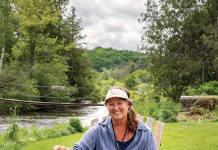Late winter weather fluctuates between swirling snow and drizzle. Though my family loves spending time outdoors, by late February, they’ve grown tired of sledding and snowmen and yearn for swimming and sunshine. Meanwhile, I dream of fishing — and not through a hole in a frozen lake. One thing’s for sure: No matter how we sugarcoat things, by season’s end, our love for snow runs icy cold.
 As evening morphs into night, I tuck the kids into bed and shuffle down the hallway to my office. A sigh escapes as I glance past the frost-rimmed window at a bleak, white landscape. Turning my attention back inside, a metal vise atop the desk catches my eye. More than a mere perch for paperwork, this desk is where I tie flies, and there’s no better time than a blustery, winter’s night to stock up for the coming fishing season.
As evening morphs into night, I tuck the kids into bed and shuffle down the hallway to my office. A sigh escapes as I glance past the frost-rimmed window at a bleak, white landscape. Turning my attention back inside, a metal vise atop the desk catches my eye. More than a mere perch for paperwork, this desk is where I tie flies, and there’s no better time than a blustery, winter’s night to stock up for the coming fishing season.
The term “flies” conjures classic images of delicate, winged insects crafted from feathers and fur and lashed to a tiny hook. While these lures can replicate conventional “bugs,” flies also can imitate other fishy foods, such as frogs, mice and minnows. The age-old art of fly tying is nothing new, especially in Michigan. The legendary Adams — one of the most famous flies of all time — was first tied near Traverse City in the early 1920s. Years later, another classic, dubbed the Griffith’s Gnat, emerged as well, and many more Michigan-born patterns followed in its wake.
Unlike those pioneers from long ago, I’m not tying anything new tonight. Instead, I’m whipping up a batch of Roberts Yellow Drakes for a far-off fishing season. Originally created by a Michigan game warden in the 1950s, this versatile fly imitates tiny sulfur mayflies (the size of long-grain rice) but can even replicate giant hex flies (nearly as big as a large dragonfly). Never mind actual sulfurs won’t emerge until May, and hex only hatch on muggy, June evenings.
 Modern flies often require synthetic materials, but Roberts’ time-tested pattern calls for organic ingredients, such as feathers and fur, so the fruits of last fall’s hunting season come in handy.
Modern flies often require synthetic materials, but Roberts’ time-tested pattern calls for organic ingredients, such as feathers and fur, so the fruits of last fall’s hunting season come in handy.
Clamping a tiny hook into the vise, I wind on a body of thread, ensuring each wrap touches the last and none overlap. Next comes a small clump of pheasant fibers for a tail, followed by a pinch of hollow deer hair to form the body. After that, an upright wing-post fashioned from more deer hair and, finally, a single, barnyard rooster feather to create a horizontal “wing.” After whip-finishing a neat head, the fly is complete. If imitation is the sincerest form of flattery, I imagine Clarence Roberts would approve of my enthusiastic plagiarism.
Though the weather outside is frigid, I feel a special satisfaction in spinning away winter’s wrath from the cozy confines of my warm office. With each finished fly, visions of balmy weather and feeding fish fill my head, and suddenly, I realize I’m warm all over.
Author and freelance writer Jon Osborn resides in Holland.







Facebook Comments